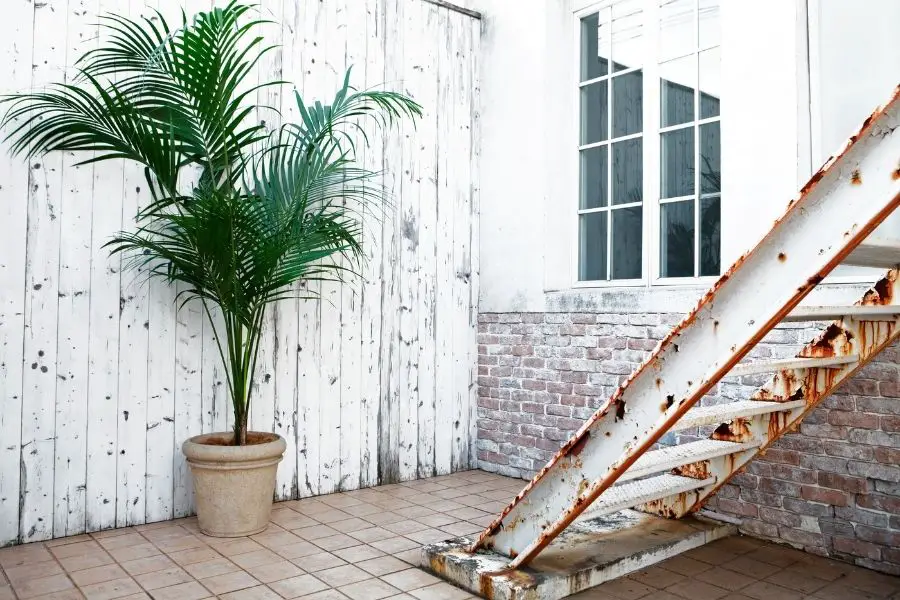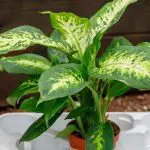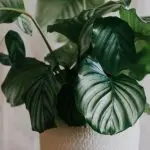- TEMPERATURE: 65 – 75 degrees F (18 -24 degrees C)
- LIGHT: Low to bright, indirect
- HUMIDITY: High
- SAFETY: Non-toxic to cats and dogs
- DIFFICULTY: Moderate
There are two species of plant known as kentia palm – Howea forsteriana and H. belmoreana. They are very similar, but H. forsteriana has wider spaces between the leaflets. H. belmoreana, also known as sentry palm, has leaves with a slight curl. Care requirements are the same for both.
Kentia palm grew in popularity in the Victorian era due to its adaptation to dimly lit European parlors. Reaching up to 8 feet in height, this plant makes a great choice for rooms with high ceilings. However, they are slow growers – especially in low light.
I would consider kentia palm moderately easy to grow. It has high humidity requirements, and as long as you keep those met while providing adequate light, it will thrive for years indoors.
Water
During the spring and summer months, keep the soil lightly moist at all times. If you touch the top of the soil and it feels dry, give the plant some water. But, never allow kentia palm to sit in water; make sure the soil and pot are well-draining.
During the fall and winter, allow soil to become almost dry between waterings. Insert your finger into the soil to the first knuckle, if the soil feels dry, it’s okay to water. This plant doesn’t need as much water in the cooler months.
Use lukewarm water when watering kentia palm to prevent shocking the roots. (That’s a good rule of thumb for all your houseplants.)
Humidity
Kentia palm needs high humidity. If the air becomes too dry, the leaves may start to turn brown.
Mist your kentia palm daily with a spray bottle of water on the mist setting or use a handheld mister. For optimal humidity, place a humidifier in the room, mist regularly, and place the pot on a humidity tray. (That’s what I like to call the humidity triple-threat.)
If you’re unsure about humidifiers, you can read my review of my favorite houseplant humidifier (the one I’m using right now) or click here to view it directly on Amazon.
Fertilizer
Feed your kentia palm using a balanced houseplant fertilizer. My favorite is Jack’s All-Purpose Fertilizer, but any all-purpose food will work. (Read my review of Jack’s Fertilizer to see why I love it so much.)
This plant only needs feeding once a month during spring and summer. You can also feed twice a month with the fertilizer diluted to half-strength if you prefer. Stop feeding in fall and winter.
Light
Kentia palm can tolerate low light conditions, but it thrives in bright, indirect light. A slow grower anyway, low light will slow growth even more. This plant does not like direct sun. If placed in direct light, the leaves will burn and develop black patches.
The best location is a south- or east-facing window, with the sunlight filtered by sheer, gauzy curtains.
This large and lovely palm benefits from spending the summer outdoors if you have a place for it. My mom always kept her kentia on a shady patio throughout the summer months, where it would grow a bit bigger every year. Then, she’d bring it back inside during fall-spring to brighten up the living room.
Temperature
Kentia palm performs best when daytime temperatures are kept around 65 – 75 degrees F (18 – 24 degrees C). It can tolerate nighttime temperatures down to 55 degrees F (13 degrees C), but only for short periods.
Never let the temperature drop below 50 degrees F (10 degrees C), or this could kill the plant.
Potting
Use a well-draining potting soil formulated for houseplants. I like this one by Happy Frog because it contains mycorrhizal fungi and beneficial soil microbes, but any good-quality potting mix will work. In addition, kentia palm benefits from amending the soil with a little sand (3:1 mix of soil to sand).
Repot only when necessary – no more than once every two years – when the plant outgrows its current container. When it’s grown enough to need repotting, repot in a container that’s at least 4 inches (10 cm) in diameter larger than its previous pot.
For the best results, repot once every three years until the plant is as big as you want it to get. Kentia palm’s roots are very fragile, so handle with care when you’re repotting.
Propagation
Kentia palm is only propagated from seeds, which are hard to get. I would not recommend trying this at home. It’s best left to professional nurseries, as it takes a very long time to grow (3-5 years).
It’s impossible to grow new plants from cuttings, and if you cut off the growing tip you will kill the tree.
Maintenance
Clean your plant’s leaves regularly with a soft cloth or sponge to remove dust and hair. No other regular maintenance is really required.
Troubleshooting
Here are some common problems indoor gardeners often have with kentia palms and suggestions for how to fix them:
- Brown Leaf Tips – If the tips of the leaves are turning brown, this is likely due to low humidity or too much sun. Increase humidity by misting more frequently, placing near a good houseplant humidifier, and/or placing the plant on a humidity tray. Make sure the plant is not receiving direct sunlight.
- Black Patches on Leaves – This is due to too much sunlight. Move the plant to a location where it only receives bright, indirect sun and make sure it is never exposed to direct sunlight. The black patches are dead tissue that the sun has killed.
Where to Buy Kentia Palm
Kentia palms are typically more expensive than other houseplants because they grow so slowly. A plant that fills a 10-inch (25-cm) pot is 3 – 5 years old. (It can last up to 20 years as a houseplant!) If you really want one, the best place to find them is on Etsy.
I love buying plants from Etsy because they’re sold by small, individual growers. I like supporting small businesses AND the growers have to care more about quality and reputation. I’ve purchased numerous plants from the site, and I’ve never been disappointed.
Click here to see the current listings for kentia palm on Etsy.
Another good place to check is on Amazon if you can’t find one of these in your local nurseries. But again, be prepared to pay. Kentia palm is not cheap.





